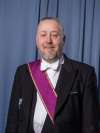Information in English
It is the name given to the assembly room or building where the Masonic brothers meet. A lodge meeting, as a rule, includes a solemn ceremony where new brothers are received into their respective degrees. These admissions are conducted within a framework of solemnity with opening and closing ceremonies, with music and rituals rich in tradition. The lodge evening closes with a simple meal in an air of informality among the brothers.
The foundation for our Masonic system is the first three degrees, which are called St John’s, Craft or Blue Masonry where brothers receive the titles appropriate to their degree - I. Entered Apprentice (EA) II. Fellow Craft (FC) III Master Mason (MM) as in accordance with the art of building.
This is followed by St. Andrew’s Masonry, which works within the IV, V and VI degrees.
The final section is the Chapter or Chivalric Masonry for brothers of the VII - X degree.
A few brothers with special responsibility within the Order may receive titles like Knight and Commander of the Red Cross XI degree.
Besides Norway’s approximately 92 lodges there are numerous Lodges of Instruction which work within the same framework as the lodges, but are not allowed to initiate new members.
The Norwegian Order of Freemasons is not a secret order. It operates openly. The list of members is available for anyone, likewise the Laws of the Norwegian Order of Freemasons, which can be read by anyone. It is evident from this that the Masonic system worked to have its basis in the Christian faith.
It is in point of fact a Christian Order, but within this framework no demands are made for adherence to special dogmas or creeds.
The Masonic learning system is closed to outsiders. Freemasonry is a school lasting a lifetime where a Mason has to work through the degrees.
The content of each degree is held closed until the Freemason himself has had the opportunity to take a standpoint on questions and challenges, which are attached to each new degree.
The Norwegian Order of Freemasons is an independent, national order, unbound and under no obligation to any foreign order unlike the other Nordic orders. There is however good co-operation between the lodges in the North and many other lands all over the world.
Each country’s Freemasons organisation is an independent Masonic society. There is no international organisation. Today there are about six million Freemasons throughout the world.
To show compassion and fellowship is an obligation for each human being, but a Freemason is especially bound and must be most vigilant in this area.
Regular collections are arranged to support and help our fellow mortals who might be in need of a helping hand. Annually a cause or institution is chosen for the Orders’ Common Gift, and a united collection is taken on its behalf.
As can be seen from the list later in the program, the Norwegian Order of Freemasons is represented with lodges and brother societies in most towns and many of the other denser populated areas of Norway.
To become a member of the Norwegian Order of Freemasons, which has today approximately 18.500 members, one must be sponsored by two members of the Order, one of whom must have obtained the degree of Master Mason. Those seeking admission must profess to the Christian faith, have reached the age of 24 and known to have stability in his daily life.
Those interested in membership must take contact with a Freemason he knows personally and who is willing to recommend him as a member. This application for membership should be a completely free decision; no one should be persuaded to become a member. It is the case of a strong personal relationship.












